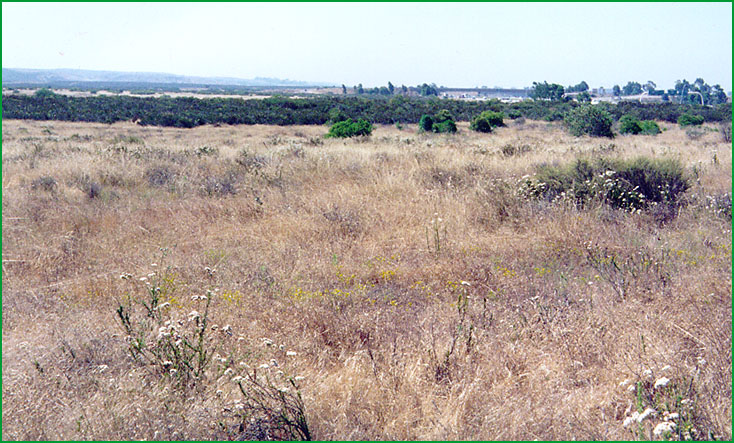 | Coastal Terraces |
Coastal Terraces at Miramar Naval Air Station Patsy Miles |
Camp Pendleton area Scott Miles |
http://www.fs.fed.us/r5/projects/ecoregions/261bj.htm
This subsection consists of dissected marine terraces along the coast from Newport Beach, at the mouth of the Santa Ana River, southeast to the Mexican border. The climate is hot and subhumid; it is modified greatly by oceanic influence. MLRA 19e.
Lithology and Stratigraphy. This subsection contains mainly Tertiary sedimentary rocks and Quaternary marine sediments. The Tertiary rocks are Eocene marine and nonmarine and Miocene and Pliocene marine sedimentary rocks. There are many small areas of late Quaternary fluvial deposits.
Geomorphology. This is a subsection of nearly level to very gently sloping marine terraces that have been eroded and dissected to expose Tertiary sedimentary rocks. The dissected terrace edges are moderately steep to steep. There is a narrow strip of beach and dune sand along the coast. Some streams have deposited recent alluvium in ponds behind sand bars. The subsection elevation range is from sea-level to about 1500 feet. Mass wasting, coastal marine, and fluvial erosion and deposition are the main geomorphic processes.
Soils. The soils are mostly Alfic Xeropsamments, Typic Natrixeralfs, and Abruptic Durixeralfs on the marine terraces and Lithic Xerorthents, Lithic and Calcic Pachic Haploxerolls, Typic Argixerolls, Typic Haploxeralfs, Typic Natrixeralfs, Natric Palexeralfs, and Chromic Pelloxererts off the terraces, on Tertiary sedimentary rocks. Soils on the oldest terrace surfaces are mostly Abruptic Durixeralfs and Ultic Palexeralfs. Psamments and Cumulic Haploxerolls are common in recent alluvium. Calcium carbonates have accumulated in many of the soils. Soil temperature regimes are thermic, and soil moisture regimes are xeric.
Vegetation. The predominant natural plant communities are California sagebrush - California buckwheat series and California sagebrush - black sage series. Chamise series is common and Coast live oak series occurs in some ravines. Pickleweed series occurs in some estuaries. Torrey pine stands and San Diego mesa vernal pools in the southern part of the subsection are unique.
Characteristic series by lifeform include:
Vernal pools: San Diego mesa vernal pools.
Dunelands: Sand-verbena - beach bursage series, Dune lupine - goldenbush series.
Saltmarshs: Cordgrass series, Ditch-grass series, Pickleweed series
Grasslands: California annual grassland series.
Shrublands: Black sage series, California buckwheat series, California buckwheat - white sage series, California encelia series, California sagebrush series, California sagebrush - black sage series, California sagebrush series - California buckwheat series, Chamise series, Chamise - black sage series, Chamise - mission-manzanita - woollyleaf ceanothus series, Coast prickly-pear series, Mixed sage series, Mixed scrub oak series, Scrub oak series, Scrub oak - chamise series, Sumac series, White sage series.
Forests and woodlands: California sycamore series, Coast live oak series, Engelmann oak series, Torrey pine stands.
Climate. The mean annual precipitation is about 10 to 12 inches; it is all rain. Summer fog is common. Mean annual temperature is about 58¯ to 62¯ F. The mean freeze-free period is about 350 to 365 days.
Surface Water. Runoff is rapid, except from undissected terrace surfaces which have vernal pools on them. Many streams that drain from the mountains across this subsection are perennial, but most of the lateral streams are dry though the summer. There are no lakes, other than temporary ponding behind sand bars.

